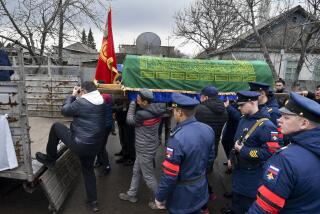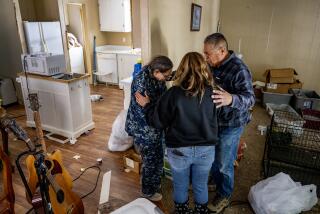Thousands of Kurds Face Hard Winter in Mountains
- Share via
GOHLAN, Iraq — For Juma Amin’s family and hundreds of thousands of other Kurds, this winter is bringing back bitter memories of March, when Saddam Hussein’s forces crushed a Kurdish revolt and they fled into cold hills.
Iraq has imposed an economic blockade, and kerosene for heating stoves is running out. There is also a shortage of gasoline in this and other villages in the rugged mountains near the Iranian border.
“The nights are icy, and we have no stove,” said Amin, who lives with his family of five in a tent pitched in a field off the slushy road.
“This is nothing,” he said, pointing at a 2-inch blanket of snow. “A week ago, it was 70 centimeters,” more than 2 feet.
About 2,000 Kurds remain in Gohlan, whose wrecked buildings were never rebuilt after a 1988 Iraqi military crackdown on Kurds.
U.N. relief agencies are getting food in despite the Iraqi blockade, and many Kurds are trying to stick out the snow and frost rather than go down to U.N. refugee camps on the plains.
Others feel they have no choice but to leave. But they are having trouble because of the gasoline shortage.
“Yesterday 30 trucks came” to take away refugees, Amin said. “Today there were only four. I want to leave this place but can’t.”
Baghdad put on the squeeze to try to pressure leaders of Kurdish insurgents into accepting its terms for an autonomy agreement. The Kurds want guarantees for democracy and control of key oil-producing areas, and the talks remain stalemated.
Fahima Mejid, an elderly woman who has rheumatism, said she had to stay in the mountains because her husband is sick. Dressed in layers of tattered clothing, she said the family lives in a tent because they have no money to rebuild their house.
She and Amin are among an estimated 500,000 refugees still displaced since March, when 1.5 million Kurds fled to Turkey and Iran after Hussein’s troops brutally suppressed the Kurdish uprising after the Persian Gulf War. The others returned after a U.S.-led military force occupied northern Iraq briefly to coax the refugees back down from the mountains.
However, Iraqi shelling of Kurdish villages in the fall, coming at the same time as the economic blockade, added 200,000 more refugees. Most of those are in camps near two cities held by Kurdish rebels, Suleymaniyah and Erbil, said Colin Mitchell, who is in charge of operations in Suleymaniyah for the U.N. High Commissioner for Refugees.
A report prepared for the U.S. Senate in November warned that the Kurds face catastrophe. It said that snow could block deliveries of food aid and noted that fresh food stocks were reduced because much land had not been farmed this year.
The Kurds’ tents can be surprisingly resistant against the freezing temperatures of night--if there is a working stove.
In Panjwin, 30 miles from Gohlan, 80-year-old Melek Kader and five relatives huddled against the cold inside their tent. Sitting near the stove, the elderly woman said she had other relatives in Suleymaniyah but they had no food to spare.
Some who have stayed are using their own labor and supplies from a special U.N. program to rebuild houses.
Amin Ghirabeh, a Jordanian field officer for the United Nations, said in Panjwin that U.N. trucks carry about 1,000 people a day down to camps of blue and green tents that splash color across the snowy landscape.
A sea of tents surrounds Sayyid Sadiq, a town near Suleymaniyah that was destroyed in 1988. Laurent Schumaker, a Belgian U.N. relief worker, said the town held 89,000 people, about twice as many as in the fall.
More to Read
Sign up for Essential California
The most important California stories and recommendations in your inbox every morning.
You may occasionally receive promotional content from the Los Angeles Times.










